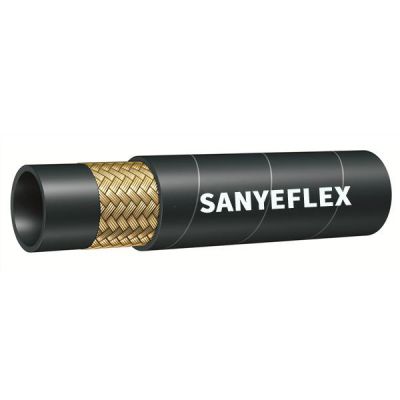Jan. 17, 2024
In this comprehensive article, we will delve into the fascinating world of industrial hoses, exploring their composition, manufacturing process, and various applications. Industrial hoses are vital components used in a wide range of industries, providing a means for the safe and efficient transfer of fluids, gases, and materials. To outrank other websites and provide you with the most valuable insights, we present a detailed examination of what industrial hoses are made of and how they contribute to the seamless functioning of numerous industrial operations.
Industrial hoses are flexible, hollow tubes designed to convey a variety of substances from one location to another. These hoses play a crucial role in industries like manufacturing, mining, construction, oil and gas, agriculture, and many more. They enable the transfer of materials such as water, chemicals, petroleum, air, and even bulk solids, making them indispensable assets for modern industrial processes.
Industrial hoses are crafted from a combination of carefully selected materials to meet the specific requirements of the intended application. The primary components used in manufacturing these hoses include:
2.1. Inner Tube Material
The inner tube is the core of an industrial hose and comes into direct contact with the substance being transported. Manufacturers choose materials like synthetic rubber, thermoplastics, or specialty compounds based on the chemical compatibility with the intended media. For example, hoses handling corrosive chemicals might utilize materials with superior resistance properties.
2.2. Reinforcement Layer
To enhance strength and durability, industrial hoses incorporate reinforcement layers. Common materials for reinforcement include textile fibers, steel wire braids, or spiral-wound steel wire. The choice of reinforcement depends on the operating pressure and flexibility required for the hose.
2.3. Outer Cover
The outer cover serves as a protective layer, safeguarding the hose from environmental factors like abrasion, sunlight, ozone, and chemicals. Manufacturers often use synthetic rubber, thermoplastics, or blends to construct the outer cover, ensuring the longevity of the hose under various working conditions.
The production of industrial hoses is a meticulous process that demands precision and adherence to stringent quality standards. The steps involved in manufacturing industrial hoses include:
3.1. Material Selection
Before commencing the manufacturing process, the engineers select the appropriate materials for the inner tube, reinforcement, and outer cover based on the application's needs. Thorough research and testing ensure the compatibility and resilience of the chosen materials.
3.2. Preparation
In this stage, the materials are prepared and cut into the required sizes and shapes. The reinforcement materials are woven or wound into the desired patterns, while the inner tube and outer cover materials are molded accordingly.
3.3. Building the Hose
The hose assembly process begins by layering the inner tube, reinforcement, and outer cover materials in precise order. Special adhesives or bonding techniques are used to ensure a strong and secure bond between the layers.
3.4. Vulcanization
Vulcanization, a critical step in the manufacturing process, involves subjecting the hose to heat and pressure to create a robust, unified structure. This process also enhances the hose's resistance to temperature extremes and other environmental factors.
3.5. Testing and Quality Assurance
Before the hoses are ready for market distribution, they undergo rigorous testing to verify their integrity, performance, and adherence to industry standards. Quality assurance checks are conducted to ensure that only hoses of the highest quality reach the end-users.
The versatility of industrial hoses allows them to serve a wide array of applications across various industries. Some common uses include:
4.1. Water Transfer
Industrial hoses facilitate the transport of water for irrigation, firefighting, municipal water supply, and general fluid transfer purposes.
4.2. Chemical Conveyance
Hoses designed to handle chemicals safely are employed in chemical processing plants, laboratories, and various industries dealing with hazardous substances.
4.3. Petroleum and Oil Handling
The oil and gas industry relies on industrial hoses to transfer petroleum products efficiently and safely during exploration, refining, and distribution processes.
4.4. Pneumatic Conveyance
Industrial hoses play a vital role in pneumatic systems, transporting gases or granular materials in manufacturing and processing applications.
4.5. Food and Beverage Industry
Hoses manufactured with food-grade materials ensure the hygienic transfer of food and beverages without compromising product quality and safety.
4.6. Abrasive Material Handling
Industries dealing with abrasive materials, such as mining and construction, utilize rugged hoses engineered to withstand the wear and tear associated with such applications.
In conclusion, industrial hoses are intricate engineering marvels, carefully crafted to perform under demanding conditions in diverse industries. The composition of these hoses, including inner tube materials, reinforcement layers, and outer covers, is tailored to meet specific operational requirements. Understanding the manufacturing process and the vast range of applications will aid in making informed choices when selecting industrial hoses for various industrial operations. We are an industrial hose supplier. If you are interested in our products, please contact us now!
Our Customer
Tel.: +86 400 0318 111
Email: admin@sanyeflex.com
Add.: #218 Zhongke Street, High-tech Zone, Hengshui City, Hebei Province, China


